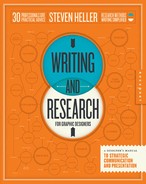
(Ray)
(Fogra 29_WF)Job:08-28858 Title:RP-Writing & Research for Graphic Designers
#175 Dtp:225 Page:108
092-109_28858.indd 108 8/30/12 4:46 PM
(Ray)
(Fogra 29_WF)Job:08-28858 Title:RP-Writing & Research for Graphic Designers
#175 Dtp:225 Page:109
092-109_28858.indd 109 8/30/12 4:46 PM
Writing & research for graphic designers
(Text)
108
FINAL EDITED VERSION
W
hen graphic design was not brain surgery, it was much
easier to practice. The new graphic—or, shall we say,
cross-platform, multidisciplinary—design is more neurologi-
cally complex than at any other time in history. Arguably, it is
more like actual brain surgery now (minus the life-and-death
consequences), with as complicated a network of synapses to
navigate as anything you’ll find in your head. It is no longer
possible to launch a graphic design career with a ruler, an
X-[A]cto blade, and a glue pot on your kitchen table. I’d bet
that if El Lissitzky, Piet Zwart, or even Paul Rand (who owned
a computer) returned from Valhalla to resume their practices,
they wouldn’t recognize the design field.
The obvious engine for these changes is digital tools and
what they have wrought. Only Gutenberg’s invention of the
printing press is on a par. Digital technologies have made it
possible [to] increase the scope of design practice a hundred
fold. Design is now tightly integrated into our daily lives, and
engineering has made visionary design concepts from decades
past more feasible. Massimo Vignelli told me that his flawed
yet revolutionary 1972 NYC subway map was “created in B.C.
(before computer) for the A.C. (after computer) era.” The map
was recently relaunched as an online interactive diagram by
NYC’s Metropolitan Transportation Authority, with all the
bugs worked out—40 years later.
The capacity to make design move in multiple dimensions is
no longer a novelty; it’s a necessity. Because if there is one fun-
damental effect of technology, among all the others, it is that
graphic design is now time-and-space-based. Understanding
the storytelling arc is essential in making analog and digital
design alike. Knowing how to move the viewer’s overtaxed
eye from point A to B to Z is a skill that was once relatively
minor. Increased data flow has turned narration into the
primary function of design. Graphic designers have always
thought about their audience, but now “user experience” is
their mantra.
The new technologies have also altered how designers ap-
proach doing business, often transforming them from service
providers to entrepreneurs. But since there are so many varia-
Final Article in Print magazine, December 2011.
tions in this flux that I asked some veteran graphic designers—
those who have lived in both the B.C. and A.C. worlds—to
reflect on how the last decade has altered their practices and,
sometimes, their lives.
(Ray)
(Fogra 29_WF)Job:08-28858 Title:RP-Writing & Research for Graphic Designers
09-C67944 #175 Dtp:225 Page:108
092-109_C67944.indd 108 9/22/12 11:26 AM
section 3
the editorial role how to edit and be edited
(Text)
109
(Ray)
(Fogra 29_WF)Job:08-28858 Title:RP-Writing & Research for Graphic Designers
09-C67944 #175 Dtp:225 Page:109
092-109_C67944.indd 109 9/22/12 11:26 AM
..................Content has been hidden....................
You can't read the all page of ebook, please click here login for view all page.
